More than 3,000 animal species in the world today are considered endangered, with hundreds more categorized as vulnerable. Currently, ecologists don’t have reliable tools to predict when a species may become at risk.
A new paper published in Nature Ecology and Evolution, “Management implications of long transients in ecological systems,” focuses on the transient nature of species’ and ecosystem stability and illustrates how management practices can be adjusted to better prepare for possible system flips. Some helpful modeling approaches are also offered, including one tool that may help identify potentially endangered populations.
One of the challenges of predicting species at risk is presented when a shift from relative security to vulnerability is that transient risk factors may not be known.
“A species or an ecosystem may seem perfectly stable when it unpredictably becomes vulnerable, even in the absence of an obvious stressor,” said Tessa Francis, lead ecosystem ecologist at the Puget Sound Institute, University of Washington Tacoma, managing director of the Ocean Modeling Forum, University of Washington, and lead author of the paper. “In some cases, modeling interactions between species or ecosystem dynamics can help managers identify potential corrective actions to take before the species or system collapses.”
Ying-Cheng Lai, a professor of electrical engineering and physics at Arizona State University, focused on the mathematical modeling process of the research.
“The Mexican gray wolf is an example of an endangered species that is experiencing a population resurgence in some areas, yet remains vulnerable in others,” said Lai. “The predator-prey relationship between the Mexican gray wolf and elk, mule, white-tailed deer, pronghorn, javelina, rabbits, and other small mammals is an example of how interspecies relationships can affect endangerment. In a general predator-prey relationship, a significant reduction in the prey population can make the predator endangered.
“These kinds of interactions, plus other factors such as the species decay rate, migration, the capacity of the habitat, and random disturbances, are included in the mathematical prediction model,” Lai continued, “and it turns out that, more common than usually thought, the system evolution dynamics can just be transient. Transients in ecosystems can be good or bad, and we want to develop control strategies to sustain the good ones and eliminate the bad ones,” said Lai.
Alan Hastings, a theoretical ecologist at UC Davis and an external faculty member at the Santa Fe Institute, notes that “As we apply these mathematical models to understanding systems on realistic, ecologic time scales, we unveil new approaches and ideas for adaptive management.
“The goal is to develop management strategies to both extend a positive ecosystems as long as possible and to design recovery systems to support resurgence from vulnerable states,” said Hastings. “Over time, as successful predictions are incorporated into the mathematical model, the tool will become more accurate.”
But mathematical models are not a panacea, cautions Dr. Francis. “While models can be useful in playing out ‘what ifs’ and understanding hypothetical consequences of management interventions, just as important is changing the way we view ecosystems and admitting that things are often less stable than they appear.”
New research on predator-prey relationships
More information:
Management implications of long transients in ecological systems, Nature Ecology and Evolution (2021). DOI: 10.1038/s41559-020-01365-0 , www.nature.com/articles/s41559-020-01365-0
Provided by
Arizona State University
Citation:
New management approach can help avoid species vulnerability or extinction (2021, January 18)
retrieved 19 January 2021
from https://phys.org/news/2021-01-approach-species-vulnerability-extinction.html
This document is subject to copyright. Apart from any fair dealing for the purpose of private study or research, no
part may be reproduced without the written permission. The content is provided for information purposes only.



